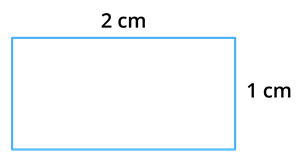PDF chapter test TRY NOW
So far we have learned how to express the square units. Now, we shall learn the conversion of given square units.
Example:
Consider a rectangle of length of 2 cm and breadth 1 cm. Find the area of the rectangle and convert its square units to mm^{2}.

Solution:
The area of the rectangle = l \times b
= 2 \times 1
= 2 \ sq. \ cm or 2 \ cm^{2}
Therefore, the area of the rectangle is 2 \ cm^{2}.
Now, let us convert cm to mm.
We know that 1 \ cm = 10 \ mm.
Which implies that the length of the rectangle = 2 \ cm = 2 \times 10 \ mm = 20 \ mm
And the breadth of the rectangle = 1 \ cm = 10 \ mm.
Thus, the area of the rectangle = l \times b
= 20 \times 10
= 200 \ mm^2
Hence, the area of the rectangle after conversion from cm to mm is 200 \ mm^{2}.
Important!
The conversions can be simply remembered as follows:
- 1 \ cm^2 = 10 \ mm\times10 \ mm = 100 \ mm^2
- 1 \ m^2 = 100 \ cm\times100 \ cm = 10000 \ cm^2
- 1 \ km^2 = 1000 \ m\times1000 \ m = 1000000 \ m^2
